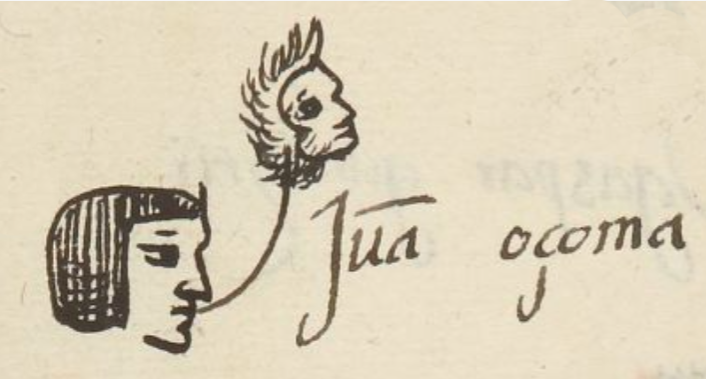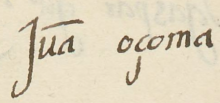Ozoma (MH486r)
This black and white drawing of the simplex glyph of the personal name Ozoma shows the head of a monkey (ozomatli) in profile, looking to the viewer's right. Its eye is open. Its hair is standing up on the top of its head and leaning forward a bit at the front. This use of Ozoma is attested as a man's name.
Stephanie Wood
The glyph for monkey very typically shows the hair (tzontli) on the top of its head standing up or leaning forward, and sometimes the hair is long and thick, and so very noticeable. Perhaps this portrayal of hair is meant to serve as a phonetic complement for the "zom" in the middle of the root ozoma, given that "tzon-" stands for hair.
The ozomatli is a day sign in the religious divinatory 260-day calendar, the tonalpohualli, so it was given as a name to babies born on its day. Because of colonial edicts to stop using the tonalpohualli as a source for names, one thing that happened is that the companion number was dropped, as is the case here, perhaps as a stopgap measure. number that usually accompanied a day name, which would reduce the sacred nature of the name. See Norma Angélica Castilla Palma, "Las huellas del oficio y lo sagrado en los nombres nahuas de familias y barrios de Cholula," Dimensión Antropológica v. 65 (sept.-dic. 2015), 186.
There was also a divine force or deity named Ozomatli, which, according to Desmond Morris (Monkey, 2013, 41), was "the companion spirit and servant of the god Xochipilli, the deity of music and dance. In paintings it is depicted dressed in malinalli herbs and with white, oval earrings with pointed ends."
Stephanie Wood
Juā oçoma
Juan Ozoma
Stephanie Wood
1560
José Aguayo-Barragán
monkeys, monos, calendarios, tonalpohualli, días, deidades, deities, divinities, divine forces, ozomatli, nombres de hombres

ozoma(tli), monkey, https://nahuatl.wired-humanities.org/content/ozomatli
tonalpohual(li), 260-day calendar, https:nahuatl.wired-humanities.org/content/tonalpohualli
el mono
Stephanie Wood
Matrícula de Huexotzinco, folio 483r, World Digital Library. https://www.loc.gov/resource/gdcwdl.wdl_15282/?sp=51&st=image
This manuscript is hosted by the Library of Congress and the World Digital Library; used here with the Creative Commons, “Attribution-NonCommercial-ShareAlike 3.0 License” (CC-BY-NC-SAq 3.0).





